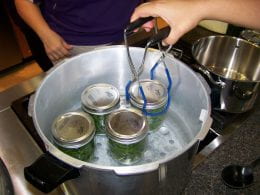
There is a lot of science that goes into a home preserved jar of food. Home canners must respect that science by using reliable recipes to make the safest product.
Heat penetration experiments are conducted to determine how heat goes through a jar of food. The “cold spot” or the slowest-heating location is key in knowing the time it takes to achieve a certain level of “lethality”, or how well the heat process destroys pathogens or spoilage microorganisms. These heat penetration studies are done for each food. It is affected by the acidity (pH), consistency, texture, distribution of solid food particles and liquids, and more.
These experiments are lengthy, expensive, and time-consuming. Therefore, the variety of recipes available are somewhat limited. There is no easy formula to apply to a new recipe without doing experiments for safety.
Making up your own recipe and canning it can be dangerous because of these reasons and more. Learn more about the science at https://nchfp.uga.edu/publications/nchfp/factsheets/heatprocessingbackgrounder.html
hgh kur kaufen
References:
hgh-x2 kaufen
I will come and read every single thing you write. You can trust me because everything you write is very good. You can trust me because everything you write is very good, interesting, unique and new. LockDown168
The content you wrote made me read it non-stop, so I had to recommend it to my friends. My friends were just as interested as I was. My friend recommended your article to me and I really enjoyed it. Thank you for writing such a great article. Lotto123